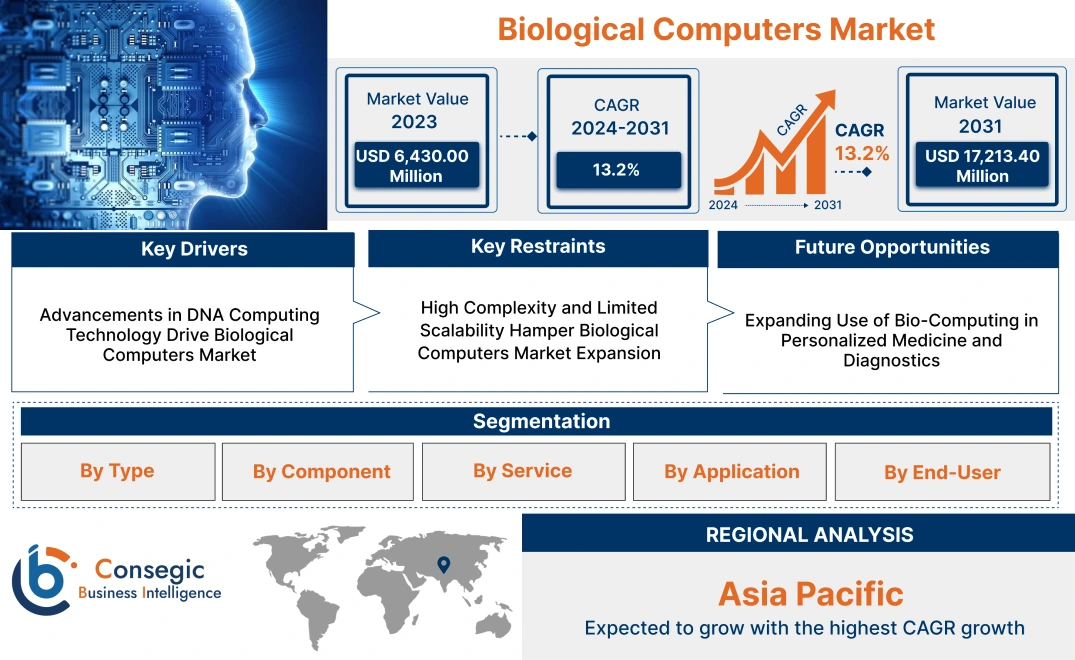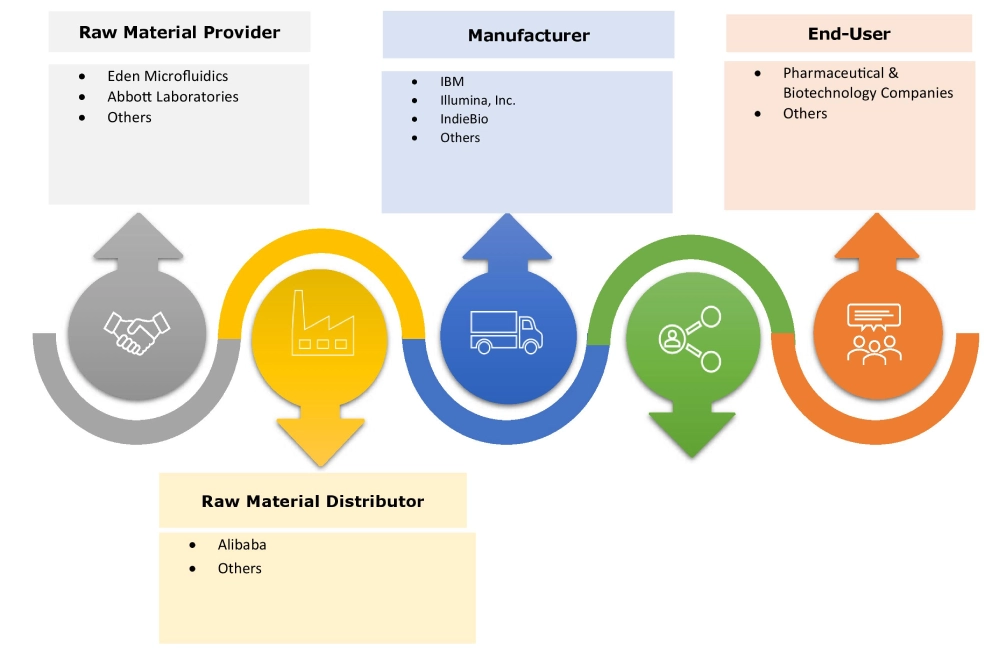Biological Computers Market Size:
Biological Computer Market size is estimated to reach over USD 17,307.98 Million by 2032 from a value of USD 7,047.67 Million in 2024 and is projected to grow by USD 7,762.72 Million in 2025, growing at a CAGR of 13.2% from 2025 to 2032.
Biological Computers Market Scope & Overview:
Biological computer is special types of microcomputers with combination of biology and computer science, which leverage biological materials for computational tasks, revolutionizing medicine and data storage. Additionally, the advantages include increased speed and efficiency, enhanced accuracy, and sustainability among others are driving the biological computer market growth. Further, the primary application include DNA sequencing, targeted drug delivery, and biosensing, among others. Furthermore, the growing demand for innovative approaches in biomedical research and healthcare is fueling the biological computer market demand.
Biological Computers Market Dynamics - (DRO) :
Key Drivers:
Growth in Research Funding Drives Demand for Biological Computer
The increasing focus towards accelerating the innovation and commercialization of biocomputers is compelling government and institutes to invest in the development of system, fueling the biological computer market growth. Additionally, the increasing investment in the field of cancer discovery as well as DNA-based computer is propelling the biological computer market demand. Further, the increasing investment in the system aims to reduce the cost and shorten the development time, which in turn is paving the way for market development.
- For instance, in March 2024, Gladstone Institutes received funding of USD 5 million to change the future of cancer by leveraging computational biology and artificial intelligence.
Therefore, the increasing focus towards accelerating the innovation and commercialization of biocomputers is driving the adoption of system, in turn proliferating the growth of the market.
Key Restraints :
Scalability and Complexity is Restraining the Market Growth
The increasing reliance on complex biochemical reactions and precise molecular interactions for development of reliable and reproducible computing devices is hindering the biological computer market expansion. Additionally, the complexity in integration of biological components with conventional hardware is restraining the market evolution.
Therefore, the increasing complexity and scalability issue is hindering the biological computer market expansion.
Future Opportunities :
AI based Biocomputer is Expected to Promote Potential Opportunities for Market Growth
The increasing focus towards drug discovery & disease modeling as well as rising adoption of AI based biocomputer is expected to create biological computer market opportunities. Additionally, AI helps in real time decision making, ideal for real time diagnostics, which in turn is propelling the market progress. Further, AI powered biochips are paving the way for development of autonomous biomedical devices which in turn is driving the market progress.
- For instance, in May 2021, Viva Biotech collaborated with BioMap for development of AI + biological computing engine from BioMap with drug discovery platform from Viva Biotech. Additionally, the collaboration aims to accelerate the R & D of the novel drugs.
Hence, the rising adoption of AI based biocomputers is anticipated to increase the utilization in turn promoting prospect for biological computer market opportunities during the forecast period.
Biological Computers Market Segmental Analysis :
By Type:
Based on type, the global biological computers market is segmented into DNA-based computers, RNA-based computers, protein-based computers, and cellular computers.
DNA-based computers utilize deoxyribonucleic acid (DNA) molecules for encoding data and performing computations. It offers high density of information storage and parallel processing capabilities, which enables users to perform substantial calculations simultaneously due to the abundance of molecules. Meanwhile, RNA-based computers utilize ribonucleic acid (RNA) molecules to carry out computational tasks. It is often used in applications including diagnostics and therapies, specifically in gene regulation and synthetic biology. Meanwhile, protein-based computers utilize proteins for performing computational operations through their complex biochemical interactions and structures. It can be used in several applications involving drug discovery, molecular assembly, and bio-sensing applications among others.
Trends in the Type:
- The advancements in DNA synthesis and sequencing are driving the adoption of DNA-based computers, which in turn is fueling the biological computer market trends.
DNA-Based Computers accounted for the largest revenue share in the year 2024.
The key factors driving the adoption of DNA based computer include high storage capacity, parallel processing capabilities, and efficiency in complex problem-solving. Additionally, the increasing focus towards big data analysis and complex biological simulations is driving the adoption of DNA based computer, which in turn is fueling the biological computer market share.
Thus, according to the biological computer market analysis, increasing focus towards big data analysis and complex biological simulations is driving the adoption of DNA-based computers.
Protein-Based Computers is anticipated to register the fastest CAGR during the forecast period.
The computers utilize proteins as computational elements for biosensing and molecular diagnostics due to ability to process signals, which in turn, is boosting the biological computer market share. Additionally, the protein-based computers are widely adopted due to sustainability, low cost, controllable hierarchical structure is boosting the market development. Further, the increasing adoption of protein-based computers for real-time diagnostic applications and drug discovery is fueling the biological computer market share.
Therefore, the rising adoption for real-time diagnostic applications is anticipated to boost the market during the forecast period.
By Component:
Based on components, the market is segmented into biological hardware (molecular circuits, biochips), software, and biocompatible interfaces.
Biological hardware primarily consists of the physical biological components that perform computations and information processing. This includes the molecular circuits, biochips, and others that facilitate computation. Software segment includes programming and informational processes that facilitate hardware operations, including the algorithms, rules, and pathways that govern biological computation. Moreover, biocompatible interfaces refer to components that facilitate interaction between biological systems and external environments or electronic devices.
Trends in the Components:
- The trend towards seamless integration of biological computers with living systems is driving the adoption of biocompatible interfaces segment.
- The rising adoption of biological hardware in pharmaceuticals and diagnostic applications is driving the biological computer market trends.
Biological Hardware accounted for the largest revenue share in the year 2024.
The biological hardware consist of molecular circuits and biochips. The molecular circuits are designed to perform specific computational tasks with the help of DNA, RNA, or proteins. Further, the increasing focus towards miniaturization of biochips with higher computational efficiency is driving the need for biological hardware, which in turn fuels the biological computer market size. Furthermore, the growing demand for high-efficiency biochips in the diagnostic and pharmaceutical applications industry is boosting the need for biological hardware, which in turn fuels the biological computer market size.
- For instance, in January 2025, The Israel Innovation Authority announced investment of USD 31 million in the development of first laboratory dedicated to bio-devices and bio-chips. Additionally, the development aims to innovate and develop advanced technologies.
Thus, according to the biological computer market analysis, rising adoption of biological hardware in diagnostic and pharmaceutical applications is driving the market progress.
Biocompatible Interfaces is anticipated to register the fastest CAGR during the forecast period.
The emergence of advanced biocompatible materials, which minimizes immune responses and enhance integration is boosting the adoption of biocompatible interface. Additionally, the increasing need for personalized medicine and tissue engineering is propelling the progress of segment. Further, the advancements in material science is driving the adoption of biocompatible interfaces segment. Also, the biocompatibility interface is majorly utilized in medical implants and biosensors, where real-time monitoring and data exchange are required.
Therefore, the advancements in material science as well as real-time monitoring and data exchange are anticipated to boost the market during the forecast period.
By Service:
Based on the service, the market is bifurcated into in-house and contract.
In-house services refer to capabilities and operations performed within an organization for developing and utilizing biological computing technologies. This usually involves research institutions, laboratories, or companies that have the resources to conduct biological computer research and development internally. Additionally, contract services involve outsourcing certain aspects of biological computing development, experimentation, or production to external companies or service providers. This approach is often utilized by organizations with limited resources or specialized needs. Contract services also offers several benefits such as access to specialized expertise, scalability, cost efficiency, and quick turnaround times among others.
Trends in the Service:
- The trend towards outsourcing complex projects to leverage external expertise and reduce operational costs is driving the adoption of contract services segment.
- The trend towards rise in subscription-based model is driving the need for contract services, which in turn is boosting the biological computer industry.
In-House accounted for the largest revenue share in the year 2024.
The development and deployment of biological computing systems within the facilities of pharmaceutical and biotechnology companies is driving the adoption of in-house services of market. Additionally, the key forces driving the adoption of in-house services is to maintain control over proprietary technologies, data security, and customization of biological computing systems. Further, the ongoing development of proprietary biological computing platforms for drug discovery, diagnostics, and personalized medicine is propelling the adoption of in-house services.
Thus, the ability to maintain control over proprietary technologies, data security, and customization is driving the adoption of in-house services.
Contract is anticipated to register the fastest CAGR during the forecast period.
The increasing popularity of outsourcing the development and testing of computing systems is driving the adoption of contract services. Additionally, the contract services offer hardware, software integration, and system validation, reducing the need for in-house capabilities, which in turn are boosting the segment. Furthermore, the expanding ecosystem of contract research organizations is propelling the adoption of contract services.
- For instance, in July 2023, The Defense Advanced Research Projects Agency received 4-year contract worth up to USD 18 million from Ginkgo Bioworks for manufacturing complex therapeutic proteins.
Therefore, the increasing popularity of outsourcing the development and testing is anticipated to boost the market during the forecast period.
By Application:
Based on application, the market is segmented into medical diagnostics, cellular & biological simulation, drug discovery & disease modeling, environmental monitoring, and others.
Biological computing can enhance medical diagnostics by utilizing biological reactions and networks to detect specific biomarkers for diseases or conditions. Moreover, biological computing also facilitates the simulation of cellular processes and biological pathways, which enables researchers to run experiments and predict outcomes in through computational modeling, prior to physical experimentation. Additionally, biological computers are capable of streamlining the drug discovery process and enhancing disease modeling through advanced simulations and analysis of biological data.
Trends in the Application:
- The increasing demand for real-time, molecular-level analysis, and advancements in bio-sensing technologies is driving the market adoption for medical diagnostics applications.
Drug Discovery & Disease Modeling accounted for the largest revenue share of 41.15% in the year 2024.
The computers are revolutionizing drug discovery and disease modeling, which in turn enables precise simulations of cellular processes. Additionally, the modelling is utilized majorly for drug interactions and optimizing lead compounds with greater accuracy. Further, growing emphasis on precision medicine is boosting the market application in drug discovery and disease modeling. Furthermore, computers reduces cost and improves predictive accuracy, which in turn are developing the market.
Thus, reduced cost and improved predictive accuracy are driving the market application in drug discovery and disease modeling.
Medical Diagnostics is anticipated to register the fastest CAGR during the forecast period.
Medical diagnostics are leveraging computers for real-time analysis of complex biological signals due to easy integration with diagnostic tools. Additionally, the rising need for personalized medicine solutions is driving the market adoption in medical diagnostics. Further, the increasing demand for advancements in bio-sensing technologies and real-time, molecular-level analysis is boosting the market progress.
Therefore, the rising need for personalized medicine solutions is anticipated to boost the market during the forecast period.
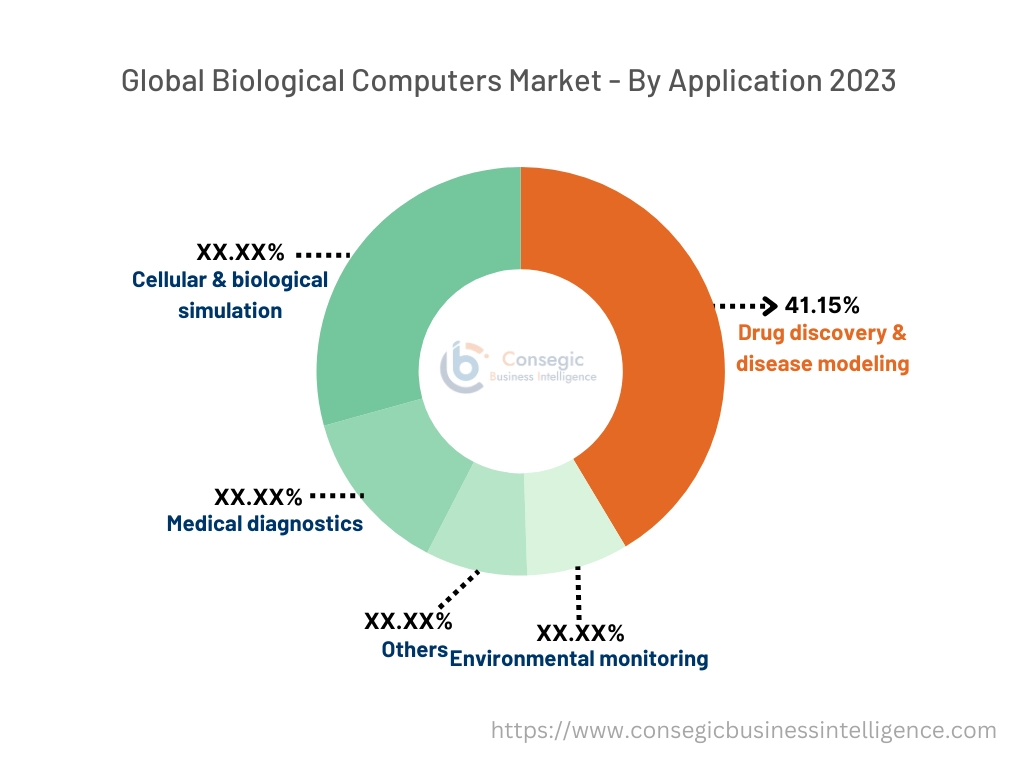
By End-User:
Based on end user, the market is segmented into pharmaceutical & biotechnology companies, academic & research institutes, healthcare IT companies, environmental agencies, and others.
Biological computing is becoming an integral part of numerous sectors, including pharmaceutical & biotechnology companies, academic & research institutes, healthcare IT companies, environmental agencies, and others. Pharmaceutical and biotechnology companies primarily use biological computers for accelerating drug development, enhancing therapeutic design, and improving understanding of biological processes. Similarly, academic & research institutions utilize biological computing to gain biological knowledge, advance scientific discovery, and develop novel applications based on biological systems. Biological computing technologies can improve healthcare delivery systems, improve data management, and develop innovative health solutions that incorporate biological insights with technology.
Trends in the End User:
- The development of advanced diagnostic tools for pharmaceutical & biotechnology companies is driving the market progress.
Pharmaceutical & Biotechnology Companies accounted for the largest revenue share in the year 2024.
The increasing focus on complex disease modeling is driving the adoption in pharmaceutical & biotechnology companies. Additionally, the integration of system in early stage drug development and clinical research is enhancing the accuracy and efficiency of drug discoveries, which in turn is propelling the market evolution. Further, the ongoing innovative drug discovery tools as well as increasing focus towards complex disease modeling is driving the market adoption by pharmaceutical & biotechnology companies.
Thus, integration of system in early stage drug development and clinical research is driving the market adoption by pharmaceutical & biotechnology companies.
Academic & Research Institutes is anticipated to register the fastest CAGR during the forecast period.
The advancing foundational research which include the development of biocompatible materials, biochips and molecular circuits is propelling the market adoption in academic and research institutes. Further, the increasing number of research projects with increased investment in the field of research is boosting the market progress.
Therefore, as per the market analysis, the increasing number of research projects with increased investment is anticipated to boost the market during the forecast period.
Regional Analysis:
The regions covered are North America, Europe, Asia Pacific, Middle East and Africa, and Latin America.
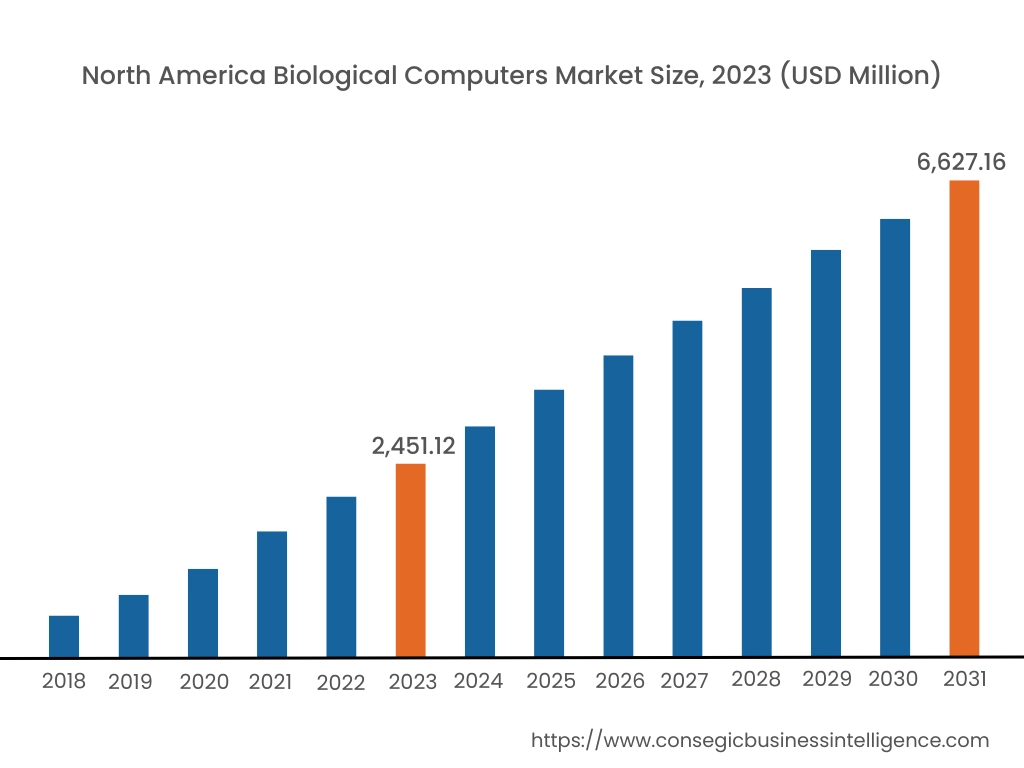
Asia Pacific region was valued at USD 1,863.97 Million in 2024. Moreover, it is projected to grow by USD 2,061.18 Million in 2025 and reach over USD 4,794.31 Million by 2032. Out of this, China accounted for the maximum revenue share of 34.18%. The market is mainly driven by advanced healthcare technologies such as medical research and biocompatible hardware. Furthermore, factors including growing emphasis on precision medicine and bioinformatics research are projected to drive the market growth in Asia Pacific region during the forecast period.
- For instance, in April 2024, AIIMS Jammu collaborated with 4baseCare. The collaboration aims to optimize treatment strategies, enhance early disease detection, and reduce the trial-and-error approach in medical prescriptions. Additionally, the collaboration aims to leverage indigenous research and government-backed biotech initiatives to integrate precision medicine and reduce cost.
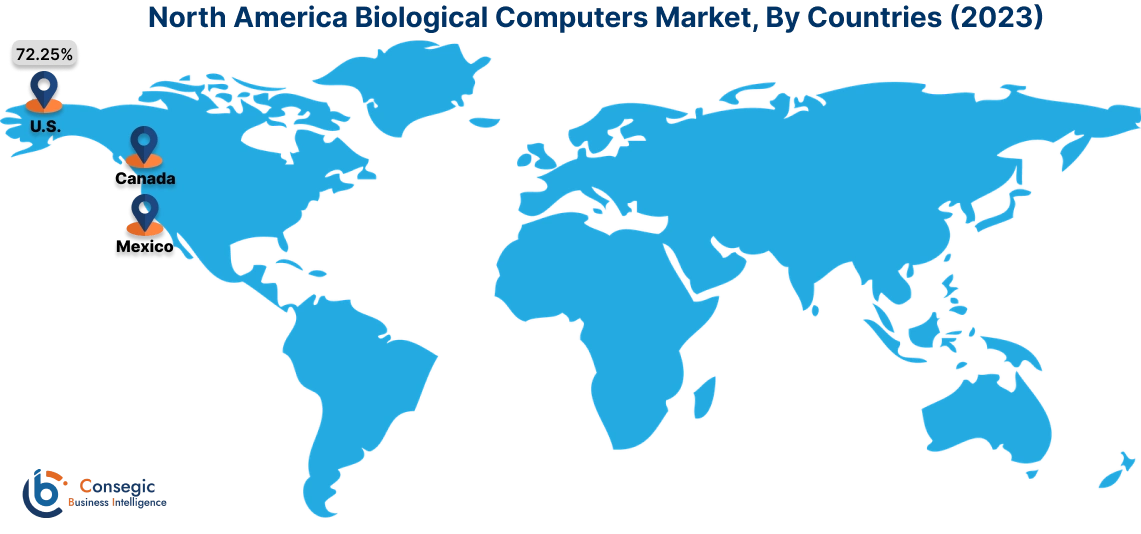
North America is estimated to reach over USD 6,360.68 Million by 2032 from a value of USD 2,708.46 Million in 2024 and is projected to grow by USD 2,972.39 Million in 2025. The North American region's growing investments in research and innovation offer lucrative growth prospects for the market. Additionally, the firms focused on developing DNA-based and RNA-based computing systems for medical diagnostics and drug discovery are driving the market progress.
The regional evaluation depicts that the robust research funding and a focus on precision medicine are driving the market in Europe. Additionally, the increasing awareness about cancer treatment is propelling the market adoption in the Middle East and African region. Further, the growing interest in using biological systems is paving the way for the progress of biological computer industry in Latin America region.
Top Key Players & Market Share Insights:
The global biological computer market is highly competitive with major players providing devices to the national and international markets. Key players are adopting several strategies in research and development (R&D), product innovation, and end user launches to hold a strong position in the biological computer industry. Key players in the global biological computer market include-
- Biometrix Technology Inc. (USA)
- Emulate Inc. (USA)
- IBM (USA)
- Sequenom Inc. (USA)
- Thermo Fisher Scientific (USA)
- Illumina, Inc. (USA)
- IndieBio (USA)
- Macrogen Corp. (South Korea)
- Merck KGaA (Germany)
- Microsoft (USA)
Recent Industry Developments :
Product Launches:
- In March 2025, Cortical Labs launched the CL1, which is a biological computer that integrates human brain cells with silicon hardware to create dynamic neural networks.
Investment:
- In December 2024, BIOMEMORY raised USD 18 million for the development of data storage appliance with biotech processes as well as advance the research into broader molecular-based solutions.
Biological Computers Market Report Insights :
| Report Attributes | Report Details |
| Study Timeline | 2018-2031 |
| Market Size in 2031 | USD 17,307.98 Million |
| CAGR (2024-2031) | 13.2% |
| By Type |
|
| By Component |
|
| By Service |
|
| By Application |
|
| By End-User |
|
| By Region |
|
| Key Players |
|
| North America | U.S. Canada Mexico |
| Europe | U.K. Germany France Spain Italy Russia Benelux Rest of Europe |
| APAC | China South Korea Japan India Australia ASEAN Rest of Asia-Pacific |
| Middle East and Africa | GCC Turkey South Africa Rest of MEA |
| LATAM | Brazil Argentina Chile Rest of LATAM |
| Report Coverage |
|
Key Questions Answered in the Report
How big is the biological computer market? +
The biological computer market size is estimated to reach over USD 17,307.98 million by 2032 from a value of USD 7,047.67 million in 2024 and is projected to grow by USD 7,762.72 million in 2025, growing at a CAGR of 13.2% from 2025 to 2032.
Which segmentation details are covered in the biological computer report? +
The biological computer report includes specific segmentation details for type, component, service, application, end user, and regions.
Which is the fastest segment anticipated to impact the market growth? +
In the biological computer market, the contract services is the fastest-growing segment during the forecast period due to increasing popularity of outsourcing the development and testing.
Who are the major players in the biological computer market? +
The key participants in the biological computer market are Biometrix Technology Inc. (USA), Emulate Inc. (USA), IBM (USA), Illumina, Inc. (USA), IndieBio (USA), Macrogen Corp. (South Korea), Merck KGaA (Germany), Microsoft (USA), Sequenom Inc. (USA), Thermo Fisher Scientific (USA) and others.
What are the key trends in the biological computer market? +
The biological computer market is being shaped by several key trends including increasing demand for real-time, molecular-level analysis and advancements in bio-sensing technologies and other are the key trends driving the market.
